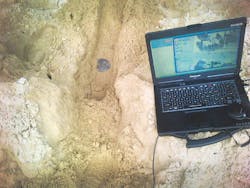About the author: Chris Kahn is GIS senior project manager for New Jersey American Water. Kahn can be reached at [email protected]
Around the world, more utilities are turning to wireless technology to help manage information, assets and workers, and American Water is one of them. In 2013, it created an enterprise geographic information system (GIS) group for administration of centralized tasks. GIS was introduced as an enterprise application that houses important information about the company’s assets and customers. This information significantly enhances the ability to cost-effectively provide customer service.
New Jersey American Water is one of American Water’s state subsidiaries that converted from a computer-aided design system to using GIS to manage its infrastructure. In addition to GIS desktop analysis and Web mapping services, the company launched a mobile GIS application in 2011 specifically designed to increase operational efficiency and improve field worker productivity.
Hurricane Sandy
GIS was put to the test when Superstorm Sandy hit the northeast U.S. in October 2012. New Jersey American Water provides water service to approximately 30% of the state’s population, and as a result of Sandy, it experienced widespread power interruptions in its service territories. The company used GIS during cleanup efforts to help identify customer premises that were destroyed by the storm, allowing it to deactivate those accounts on its records and notify customers of its actions. Not only did the company provide an enhanced service to customers, but it eliminated calls to the customer service center.
Mapping Impact by Water Consumption
A GIS map also can be used to analyze water use for customers. For example, New Jersey American Water used a map that displayed the percent change in water use month to month during the summer of 2010 by census block group. During that hot summer, the company used communication channels to request that its customers reduce water use. The map indicated that the requests had an effect beginning in August. Some block groups, however, did not reduce consumption. Further analysis of this data will help improve future communication efforts for customers.
Customer Service Benefits
Before mobile GIS was introduced, American Water utility employees received printed map updates roughly every three years. Sticky notes were used to remind employees of map errors and new installations, which often did not make it to the printed books. Not only did these books take time to produce, they also were expensive and immediately out of date. Mobile GIS eliminates annual printing costs and saves roughly 500,000 sheets of paper and ink.
Updating a deployed GIS mobile map for hundreds of users now takes only 30 minutes, and the map can be updated as often as needed. Map revisions are now sourced from a field staff of more than 200 workers, exponentially enhancing the research ability of fewer than five GIS editors. Mobile GIS manages more accurate, current information about the utility’s distributed assets, making the most current data reliably accessible to field workers.
With mobile GIS, new map data are available every Monday morning and workers now can create digital notes, sending map error locations and descriptions directly to the GIS staff through the application. Additionally, the mobile system has a satellite view that allows workers to see curbs, catch basins, manholes, etc., and measure distances on screen. The GIS staff receives the notes and then corrects the map data, so that everyone benefits when the weekly update is available. Turnaround time on map updating has improved from years to weeks.
Data updates for mobile GIS maps are sent to field tablets via the Internet; however, the data then are stored locally on the computer. As a result, mobile GIS is fast and reliable and, unlike Web maps, requires no Internet connection to operate while in the field. Field staff can annotate map errors while disconnected from the network, and when a connection becomes available, they can post those notes to GIS staff for correction.
The mobile GIS application has been released to all major distribution centers and to specific field personnel at 14 of American Water’s state subsidiaries. A gallery of interactive maps designed by the New Jersey American Water GIS can be found at http://bit.ly/njawmaps. GIS already is beginning to display every connection in the community, allowing workers to instantly identify individual customers affected by company work, outages and more.
Download: Here
